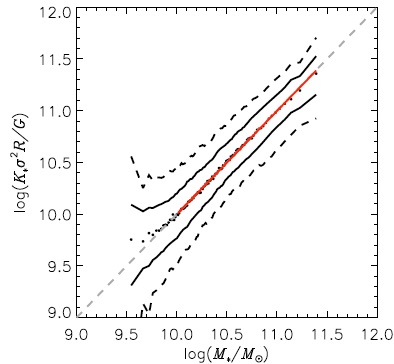
I spent much of my time as a Clay fellow exploring how stellar velocity dispersion can be used to understand quiescent galaxies. The SDSS has provided a benchmark sample for understanding velocity dispersion in the local universe. Prior to the works shown below, at intermediate and high redshifts, velocity dispersion measurements were limited to a few hundred galaxies. We’re making a systematic effort to study the velocity dispersion and the results are exciting! Our results indicate that that stellar velocity dispersion is a fundamental parameter of galaxies which is closely related to the dark matter halo. These results of this work are presented in a series of papers (Zahid et al. 2016a, Zahid et al. 2016b, Zahid et al. 2017, Zahid et al. 2018).
The plot above shows the stellar mass fundamental plane for galaxies at z<0.6. The red and blue points are from observations we made using Hectospec on the MMT. The black points are data from SDSS. We conclude that the stellar mass fundamental plane does not significantly evolve over this redshift range. This places strong constraints on the dynamical evolution of quiescent galaxies. These samples are not complete thus we can only examine the relative evolution of the stellar mass fundamental plane.

We examine the evolution of the relation between stellar mass and velocity dispersion using a very complete (~95%) spectroscopic sample. For these data, we lack HST imaging so we are not able to derive the fundamental plane. Still, the relation we measure places strong constraints on quiescent galaxy evolution. The relation is consistent with what is expected from virial equilibrium and it does not evolve out to z<0.7. The most exciting aspect of this work is that it suggests that the stellar velocity dispersion may be an unbiased tracer of the dark matter halo velocity dispersion.


The relation above is the relation between velocity dispersion and total mass. The black points are the galaxy cluster sample and the blue line is the theoretical relation between dark matter halo mass and dark matter halo velocity dispersion from N body simulations. The black curve is our data where we have determined total mass for a standard stellar-to-halo mass conversion and have taken the stellar velocity dispersion as a proxy of the dark matter halo velocity dispersion. The consistency between our data and the blue line suggest that the stellar velocity dispersion is a good tracer of the dark matter halo velocity dispersion.
We tested the observational result suggesting that the stellar velocity dispersion traces the dark matter halo velocity dispersion using hydrodynamical simulations. It turns out that the stellar velocity dispersion is a direct proxy of the dark matter halo velocity dispersion. Dark matter halos are in virial equilibrium which means that the velocity dispersion is correlated with dark matter halo mass. Thus, the stellar velocity dispersion---which is an observable property---directly links galaxies to their dark matter halos! The figure above shows the correlation between stellar velocity dispersion and dark matter halo mass for galaxies in the Illustris hydrodynamical simulation.

This is an important result because this so-called archeological approach which is based on looking at galaxies at a single epoch as a function of some age parameter is not consistent with direct look back measurements. To put this another way, when we look at older galaxies in the population today, by comparing to direct measurements at earlier epochs we conclude that they underwent evolution after they stopped forming stars. The really interesting thing is that careful analysis of low and intermediate redshift samples should definitively uncover the physical process or processes responsible for the evolution of quiescent galaxies.


The two results above suggest that quiescent galaxies are in virial equilibrium. I examine this in detail using the SDSS data. The plot above shows the relation between a dynamical mass estimator and stellar mass. The relation clearly depends on Sersic Index which is a measure of the structure of the galaxy as traced by the light profile. In fact, this dependence is expected from the virial theorem. Once we account for galaxy structure we find that stellar mass and dynamical mass are directly proportional. This is shown in the lower of the two plots.

Based on these results, I conclude that galaxies are in approximate virial equilibrium. Thus, the tilt of the fundamental plane is likely due to mass-to-light ratio variations and structural non-homology.
We also found that the virial properties of galaxies in the local universe are strongly correlated with stellar population properties, i.e. the Dn4000 index. This suggests that the age of the stellar population is related to intrinsic properties of the galaxy. An example of this is shown below.